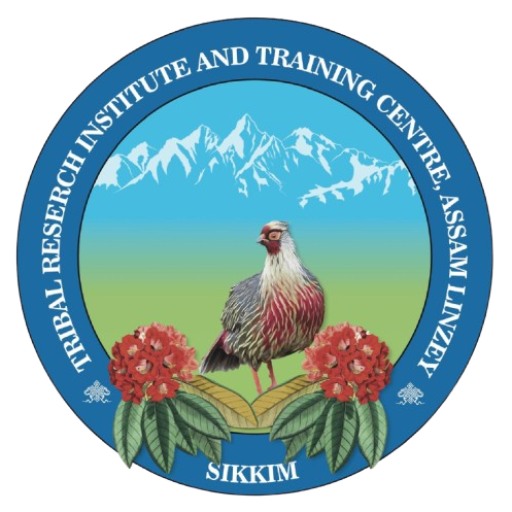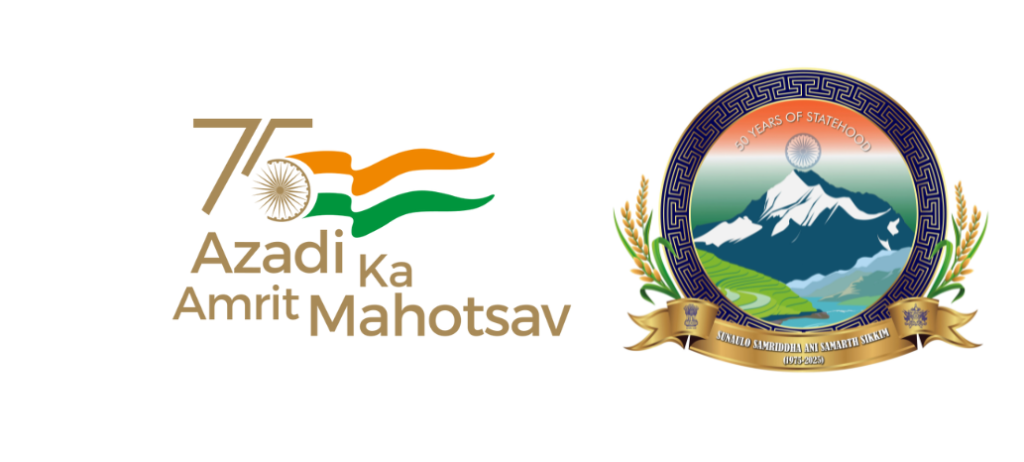LIMBOO TRIBE
ORIGIN AND ETHNO HISTORY
The historian and anthropologist working in the country have divided the people of India in to various ethnological groups and categorized the people of India in to seven ethnological types. The word “Kirata” or Kirati, a derogatory word was termed by Aryans for the ancientmongoloid people inhabiting the Himalayas about 2000, B.C. who were trading a medicinal herb, Chireto (Sunghing) in Limboo Language when they came in contact with them. It is not known what they used to call themselves, 4000 years ago. The present day three ancient mongoloid people, (Ancient Kiratas) – the Limboo(Yakthungba or Limboo) KhambuRai (Kirawa) and Yakha called themselves as “Susuwa Lilim Yakthum Suwang” or Yakthumba “Khambu”, “Kirawa” and “Limboo Yakha” or “Khambu Yakha” respectively, (Sinha et. Al 2005, Subba T.B 1999). There is not a single word as “Kirata” in their ancient oral tradition known as “Mundhum”. The Limboos believes that they are the descended of Sawa Yethangs and called themselves as “Susuwa Lilim Yakthum Suwang” since antiquity. From this the term Yakthumba, Limboo” or Limbu, “Subba” or Subha etc has been evolved in due course of time.
In the Mahabharata, the Kiratas has been described as dwellers of Himalayan region, particularly the eastern Himalayas (Satavaleker &Sharma 1969). Their seven principalities situated in the eastern Himalayan region on the north of Videha have been distinctly referred to.
We are told that their seven kings (Chiefs) were closely living to Indrakeel Mountains (Sikkim) and ruling over a vast dominant. It has been rightly observed that the great Epic of Mahabharata – mentions several principalities all along the border line of the Himalayas ruled by the Kirata Kings… (Nath..1948). The tradition of calling the Kirata Chiefs “Subba” and “Rai” in Nepali virtually commence in the early medieval period. The Kirata Chiefs represented by Subba and Rai are still found in the hilly areas of present areas of Nepal, West Bengal and Sikkim. They still have an age-old seven clan among themselves. Some of them represent the posterity of the seven Kirata chiefs of the epic age (Singh 1990, 354). Sprig says that an early reference to the Limbus as “Tsong” or “Tshong” in the Hooker’s “Himalayans Journals” (185/1905); next to the Lepchas, the most numerous tribes in Sikkim is that of Limbus (called “Chung” or “Chang” by the Lepchas); they abound also in East Nepal, which they once ruled (Hooker 1854, 194). Mainwarings Lepcha – English Dictionary gives “Tsong” as borrowed words from Tibetan, they mean, “the Limboo Tribe according to Hooker (I; 137) from Tibetan Tsang (Sic, Gtsang) province of Tsan, according to Mainwaring Waddel the “Merchant people”. ‘The Gazetteer of Sikkim” cites Waddel explaining, “the Lepchas and Bhutias call them “Tsong” (which in the vernacular means “a merchant” and the Limbus used to be the chief cattle- merchant and butchers in Sikkim) (Rishley 1894; 37). He further says that the word “Tshong or “Tsong”, is important because it occurred in the Treaty of “Lho-Mon-Tsong-Sum”,the Treaty signed by the leaders of the three races in 1666 A.D. ‘Water Hare Year’of the Tibetan Calendar through which the existence of “The Greater Sikkim” occurred and which also identifies the Tibetans, Lepchas and Limbus as the original races of the kingdom of Sikkim in the time of the first Chogyal,(King)(1642–70);
In indisputable fact of the Limboos’ contribution to Sikkim is the appellation of Sikkim itself (Sinha A.C. 1975). Tensung Namgyal the second king of Sikkim who succeed his father Phontsok Namgyal in 1670 A.D, married thrice. His third Queen was Thungwa Mukma, daughter of Yo-Yo-Hang (also called Yongyang Hang the King of Limbuwan during mid- Sixteen Sixties. Tensung Namgyal shifted the capital from Tasitenka, Yaksum to Rabdentse in 1760’s. Oncompletion of new palace at Rabdentse, the Limboo Queen was asked to name the same. She named the “Song-him”, which in the Limboo language means “New House”. But over the years the word “Song-him “metamorphosed to “Sikkom”, “Sukkim” and then“Sikkim”due to mispronunciation. This fact has been officially accepted and authenticated by the Gazetteer of Sikkim H.H. Risley – 1894 (Risley H.H. 1894, Subba J.R. 1999, 91- 154- 2008a, 1-74; Report of OBC Commission 1998).
CLANS AND KINSHIP
The Limboos are divided in to a number of exogamous patrinial thars (clans) and sub- thars (sub-clans). There is no caste system in Limboo community. Other caste or tribes adopted by the Limboo families as well as married by Limboo individuals are also included in the respective Limboo clan or sub-clan of thar community by the Tumyanghangs, (Limboos community council) after a ritual touching Shamyok (Dubgrass) and stone with promise (Laabokhey-Nambokhey Sakey –Yeksingmang) known as Samyoklung – Thim. Pedigrees of various groups of Limboos are maintained. Khagendra Singh Angbohang (1978) has listed 218 Thars and Sub-thars, under 16 major Thars, the thar Mabohang listed 20 sub-thars, Thegim 11 sub- thars, Shreng 10 sub – thars, Phago 20 sub- thars, Sawa 19 sub-thars, Bokhim 05 sub-thars, Khoyohang 17 sub-thars, Nembang 14 sub-thars, Hukpahang 17 sub-thars, and Khewa 22 sub-thars. Regulations of marriage alliances and indication of decent are the main functions of the thars and sub-thars.
NOMENCLATURE
The Limboos also use the alternative spelling Limbu which is most popularly known in Eastern Himalayas of Nepal. In addition, Limboo is how the Limboos of Sikkim identify themselves. From official documents to common day usage, Limboo/Subba is widely accepted and used among Sikkimese Limboos. Today, there is a growing movement in Sikkim to rename their titles to Limboo/ Subba. The Limboo organizations of Sikkim have been on the bandwagon to change the same because Limboo/Subba was more popularize. This shift was parallel with the growing tendency among Limboos elsewhere to validate their identity as they have begun using Limboo/ Subba as their last names. Before, people either used Subba or their clan name for instance;Muringla, Nembang, Khamdhak, Tamling etc, for their surnames, but today they use Limboo/ Subba. The uniformity in their surnames is an exertion being practiced across the Limboo world to show oneness within the tribe. Moreover, to rectify the different title which often creates confusion among the non-Limboo. It is hoped that having a Limboo/ Subba surname instead of the different clan names, as surnames would club all Limboos together and identify them across the world.
Yakthum is an endonym used by Limboos among themselves. Yakthum is often just the shorter version of what they call themselves to be Yakthumba, a word derived either from Susuwa Lilim Yakthumba. But, no one is ever found to have used this as the title. These days however,Yakthum is gaining popularity as a title and there are those who write Yakthum in place of Limboo for their surnames too. Yakthum is also used with a suffix depending on the gender of the person. A male would be Yakthumba (ba refers to male) and a female would be a Yakthumma (ma refers to female). In any villages, villagers would often ask kheney Yakthum ma ba? Which can be translated as “Are you a Limboo?. Subba means ‘village chief’ and is commonly used in both Sikkim and Nepal. In addition, another name is Tsong, which was given by the Bhutias and Lepchas of Sikkim.
Etymology of the title of Limboos has undergone different interpretations. They are addressed by different titles often times creating confusion to the people belonging to non-Limboo community. So, one must not misinterpret addressing them differently. All the titles identify the same Limboo.
No doubt, there erupted a big problem in the use of different surnames by Limboo’s, before and after they got the recognition of Tribal statusin the year 2003,andeven thereafter to till date. They were in confused state of mind as to which surname is to be used for official purpose for those whose Documents are processed officially other than “Limboo” i.e. Subba, Tsong, Yakthungba andLimbu.
Now these doubts have been cleared to all vide Notification No. -GOS- 32/SJE&WD/WD/2018 Dated-27/08/2018, which has been clearly mentioned that, “where as, the Limboo and Tamang communities of Sikkim have been included in the scheduled Tribes vide constitution (Sikkim) Scheduled order 1978, as amended, vide the scheduled castes and scheduled Tribes order(Amendment) Act 2002 (10 of 2003) dated 7th January 2003.”
Nowtherefore, in supersession of Notification No.GOS/1(32)STE&WD/WD/54, Dated 12th March 2008, the state Govt. is here by pleased to recognize and declare the following communities of Sikkim as Scheduled Tribes as included in the list of Scheduled Tribes vide the (Constitution) Sikkim Scheduled Tribes Order, 1978 namely,
- Limboo
- Tamang
Explanations: The Expressions “Limboo” Includes “Limbu, Subba, Tsong and Yakthungba” It is for the general information of all concerned that the benefits due and eligible tobe extended to the Scheduled Tribes in the state of Sikkim are extended to members of Limboos and Tamang Communities in terms of constitutional provision as applicable.
POPULATION AND SETTLEMENT PATTERN
Community wise population data of the Limboos of Sikkim is not available except for 1891 census. During 1891 Census, the Limboo population was 1,255 males, 1,159 females and 942 children, making 3,356persons. The Limboo population constitutes about 11.02% of the total population next to the Lepcha, Bhutia and Khambhu – Rais. The Limboos were 4TH amongst the communities of Sikkim. Based on the 2004 voter’s list of Sikkim, the projected population of Limbos constituted 54,750 persons (Number of voters X 2.14) about 9.15% of the total population of Sikkim in 2004. The Limboo population was 4th highest even in 2004, next to the Khambhu-Rais, Bhutia, Chettri and Bhahun community in the state. There is a decrease in percentage Limboo population by 1.87% from 1891 to 2004 (in 113 Years) period (Subba J.R. 1999; 2008; 300)
Summary of household survey conducted in 1999, covering all the blocks of Sikkim Was as follows:-
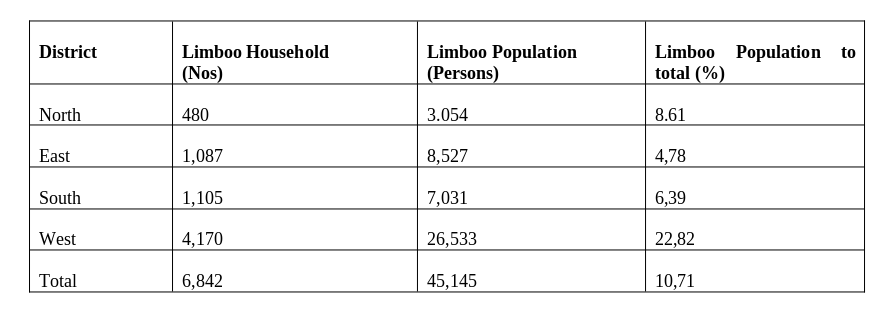
North Sikkim was divided in to 21 Gram Panchayat and Pipon system with 51 Revenue Blocks. Out of it 26 Revenue Blocks were having 480 Limboo households with Sikkim had 116 Revenue Blocks divided in to 39 Gram Panchayats, out of it 90 Revenue blocks were having 1087 Limboo Households with 8,527 persons constituting 4.78 % of the total population of the total district. South Sikkim had 42 Gram Panchayat unit with138 Revenue blocks. Out of this 93 Revenue blocks were having 1,105 total Limboo Households, with 7031 persons, constituting 6.39% of the total population of the district. West Sikkim had 43 Gram Panchayat units and 177 Revenue Blocks. Out of it 166 blocks had 4,170 Limboo Households with 26,533 persons, constituting 22.82% of the total population of the district. Thus, the state had 6,842 Limboo households with 4,515 persons constituting 10.71% of the total population of the state. The Limboo population is mostly concentrated at Daramdin, Soreng, Hee Yangthang, Bermiok, Maneybong-Dentam, Lingchom, Khanisirbong, Samdong, Sribadam, Yoksum, Tashiding and Darap in the West Sikkim, and Namfok, Rabitar, Salghari, Tingmoo in South Sikkim, Assam Linzey, Aho and Pakyong in East Sikkim and Mangshila in the North Sikkim. (Subba J.R.1999; 153; 156)
According to the 2005-06 State Socio Economic Census of Sikkim, the population of Limboo community comprised of 56,959 persons constituting 9.79% of the total population of Sikkim. Out of total 1,11,880 Households in Sikkim 10.703 households belonged to Limboo community constituting 9.75% of the total population of state. While the average number of households in Sikkim was 5.20, in case of Limboo it was 5.32. While sex ratio for all communities in Sikkim was 920, among the Limboo it was 933.
The Limboo settlement in Sikkim is a farmhouse type in general. Most of the people in rural states (7% as per the Population census 1999 are basically mixed farmers, and depend on forest for food, fuel, fodder and timber. The villages in Sikkim constitute important socio-political units play a dominant part in their life and activities. The villages are generally situated on the slope of hills are known as Busty. Each busty is now known as administrative block unit as Borbottey block, Banduckey block, Sopakha block etc. Two or three such block from a Panchayat unit, and a number of particular numbers are there in a block administrative centers of the sub-division. The state has been divided in to four districts Administrative Centre and nine Administrative sub-divisions. Particularly, the state has been 32 constituencies. The selection of the settlement sites of the villages in this part of the country is mainly guided by proximity to the water sources and the abundance of suitable cultivable land.
THE LIMBOO HOUSE
Each village composed of number of domiciles and in a domicile, besides the dwelling house, there are other huts, such as granary, farmhouse, granary -cum –guest house (paali heem) etc. the cattle shed, piggery shed goatary shed or fire wood shed etc. are often found attached to the dwelling house. A short description of a typical Limboo House is given as follows :
The dwelling house of a Limboo is known as “Khim” or “heem” in Limboo language which has generally a rectangular ground plan with a rectangular roof with winged flapped the two narrow sides(laphy), made of bamboo mat or (chim),the floor of the house is generally made of mud or wooden planks and the walls stones or mud or with mud and decorated or washed with white colored mud (khamphutla) on the upper walls and red colored mud (khamhetla) on the lower walls respectively. The roof is supported by a number of good-sized undressed timber pillars which are inserted on the ground side which known as “Sitlang”.
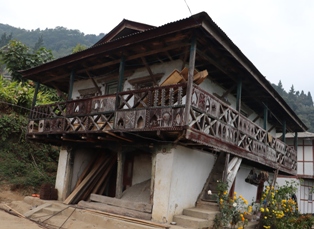
The main pillar at the center is known as “Hangsitlang”. And it extends up to the roof of the house. Use of the nails or screws for construction purposes, are limited and rare. The big wooden beam meant for supporting the roof are generally inserted through one another in a criss-cross way and the top of the roof is supported by a horizontal beam known as “Pangsing” . The main entrance to the house is generally situated in the front side towards the elevation of the hill where there is a back door also. The dwelling house is generally consists of two rooms, one Kitchen-cum- storeroom and in each of these rooms at least one window can be found. Sometimes the houses have only a big hall with no partition. The houses are quite well ventilated having sufficient light. But, in the front and backside portion of the house, there is small verandah or “sikuwas” which are used as sitting room or drawing rooms. The corrugated metal sheets have replaced the thatch grasses or bamboo mat now. In the middle of the house inside is a little raised or sunken fire place for cooking food. Just above the fireplace (Sumhatlung), a raised like area is used for keeping meat and other items. There is a worship place known as Mangdhan at the corner.


On the other four corners of the houses are the windows. The doors are locked with wooden “agloo” from inner side and an iron chain (sangli) from outside.
FAMILY PATTERNS
The ‘Yuma” religion has a tremendous influence on the child-life, youth- life, marriage, adult life, old-age life, social structureand social activities of the all Limboos. The family is the most fundamental, vital and social unit of theLimboos.Nuclear family is more prevalent, but stem family are also commonly present. A few horizontally extended families are to be found. Bonds of love and affection tie all the family members together. There has been a rise of nuclear families and decline of the extended families. It is expected that all the family members help to each other at times of the need and distress. Father is the head of the family. In the absence of father mother takes charge of the family or the eldest son or eldest daughter who is capable of controlling the household affairs is the family head.
FOOD PRODUCTION, HUINTING, WILD-FOOD GATHERING AND FOOD HABITS
Limboos are mixed farmers depending on both agriculture and animal husbandry. They are mainly cultivators and their cultivable fields are situated on the slopes of the hills either in the vicinity of the village or at some distances from it. The agricultural product is insufficient to support the family. About 25% of their food requirement is made through hunting of wild animals and gathering fruits, rhizomatous and bulb crops, and vegetables from forest’ nearby stream banks and riverbanks. Rest of their food requirement is made through mixed farming, Government subsidized food and market purchases. They rear all types of domestic animals such as poultry, duck rearing, piggery, rearing goat, sheep, buffalo and cattle.
Limboos are non-vegetarians, pork is their most preferred meat, and many eat beef and buffalo. Depending on their thar, prohibition (taboos) of eating chicken or mutton or buffalo etc. are there in different thars. For example,Khewa thars do not eat chicken, Nembang thars do not eat mutton, Mangyung thars do not eat buffalo. The thars included in Lhasa-Keyubas eat beef. Similarly, many thars included under Kanshi Kethangbas do not eat beef. Rice is their staple food. They produce finger millet for preparing and offering fermented beer to their deities. They produce various kinds of pulses (dal), soya beans etc. both both for consumption and offering for their deities. They produce different kind of mustard oil and pig fats in early years as cooking mediums. They consume and offer various kinds of roots and tubers such as sweet potato, cassava, greater yam colocasiaetc. Various kindsof seasonal fruits and vegetables. Now, they also started growing commercial flowers. They drink alcohol both homemade and purchase from market. They take milk, milk products, potato, and all other vegetables. They smoke cigarette and loose tobacco.


(Locally made Tobacco cultivated in the interior village of West Sikkim)
The Limboos are one of the aboriginal tribes of Sikkim Himalayas and thus, they have a tremendous indigenous knowledge on food and other Livelihood Bio-resources management (Hunting and Gathering) culture. However, with the growing Environment awareness of the young generation of twenty-first century, and the State Government proactive drive of Environmental and Biodiversity conservation, this beautiful cultures being disappearing very fast. The Limboo tribes of Sikkim were at the stage of go-between food production and hunting gathering of food-resources during the middle of the nineteenth century when Dr. J.D.Hooker visited Sikkim in 1849. The underlying reasons, why this transition was continuing for many years is that the food production system evolved as a result of the accumulation of many separate decisions about allocating time and effort. Foraging human, like foraging animals, have only finite time and energy, which they can spend in many ways. For example an early farmer waking up and asking; shall I spend hoeing my garden predictably yielding lot of vegetables several months from now; shall I go for fishing predictably yielding a little fish today; or hunting deer possibly a lot of meat today but more like nothing? Human and animals foragers are constantly prioritizing and making effort-allocation decisions, even if only unconsciously. There were the questions often asked by an incipient farmer inhabiting near the forest, waking up in the morning even before 1890s or even in 2000 A.D.in Sikkim when the state Government had not notified total ban of forest and river extraction of food resources. They concentrate first on favorite foods, or one’s that yield the highest pay off. If these are unavailable, they shift to less and less preferred foods. Many considerations enter in to these decisions. People in the rural areas seek foods in order to satisfy their hunger and fill their bellies. They also crave specific foods, such as protein-rich food, fat, salt, sweet fruits and foods that simply taste good. Thus, the Limboos of Sikkim have not chosen farming so consciously, because there was no other nearby farmersfor them to observe in the beginning.However, once the food production had arisen in one part of the continent (state of West Bengal and neighboring country of Nepal), the hunter-gatherers of Sikkim could see the result and made conscious decisions. In some cases the hunter-gatherers adopted the neighboring system of food production virtually as a complete package, in others they chose only certain elements of it, and still others they rejected food production entirely and remain hunter-gatherers (Diamond J .1997;104-112;Subba J.R. 208: 1-36).
Only in the decade of the last nineteenth century (1890s A.D.), the colonial British Administration started settlement of the Nepalese from Nepal by clearing the forests and thus, started settled agriculture on permanent basis. The rule of bench terracing of land for cultivation by the tillers started by the 10th Chogyal Sidkyong Tulku, was accelerated in Sikkim after 1890s in Sikkim.
LIMBOO CUISINES
According to the self-study book on food and drinks published by Kirat Yakthung Chumlung Nepal (2002), and Subba (1999) the inclusive food and drinks of the Limboos are:
Food Items
Rice is the most popular food item of the Limboos. Besides, Chyakhla ko Bhat food cooked out of crushed maize grain), Ddhero (food cooked out of maize or finger millet flour) Poponda (bread of maze, finger millet or wheat flour cooked under burning fire) Lungdhakcha, (food prepared from freshly harvested maize floor wrapped maize husk), Sigolya or Pennagolya, (food prepared out of barley or finger millet flour made in to lumps and cooked), Kangbha, (wheat, barley, & millet lumps put into rice and cooked), Penna Manda, ( food prepared like soup out of finger millet flour), Khareng (roti, bread prepared out of finger millet, barley or maize, buck wheat flour prepared on tawaor bhumbro) are the special food cuisines of the community.

Penna Manda
(food prepared like soup of finger millet flour)

Bread of Buck wheat
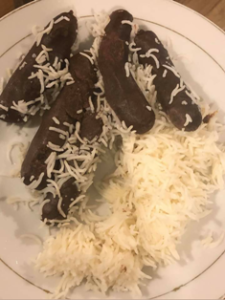
Kangbha
(wheat, barley, & millet lumps cooked with rice)
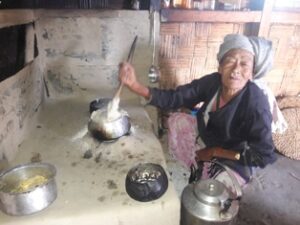
Dhero
(food cooked out of maize flour)
Curry items
Vegetable curry is the most popular curry of the Limboo community. Besides, Chembighik, (fermented Soya bean), Kinima Sumbak (fermented Soya bean curry) Yangben (curry prepared out of macro-Lichen collected from the trees), Yangben Sumbak, (food prepared out of macro-Lichen collected from the trees and pork meat with pork blood), Sargyangma or Karjyang, (Pork Souses), Sagie Sumbak (Nettle curry), Nakthuk Sumbak (Mushroom curry), Kattakwa nock sumbak (Fern curry), Fanock sumbak (bamboo shoot), Kasakpa (meat of pork fats) Yanglukma sumbak, Sirukma sumbak, Khiringtukma sumbak, Khekrokma sumbak, sura sumbak, Sarakeek sumbak etc.are some of the special cuisines of the community.

Chembighik – Kinema
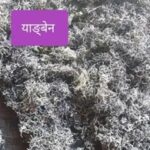
Yangben – Jheo

macro-Lichen

Sargyangma, Pork Sausage
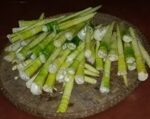
Fanock, Bamboo shoots
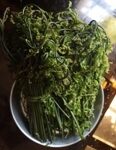
Kattakwa nock – Fern

Yanglukma – Species of frog

Sahsungay Sagi – Nettle
Karhi or Dal
All type of pulses are eaten as dal/karhi by the Limboos. But, soya bean is taken as pulses and is the most popular. Among the other pulses mung-dal (kalo-dal, paheli-dal) peas, beans are most popular.
Achar items
Phillingey machhi (Achar of phillingey) Nambong Machhi (Achar of perrila seeds) Phando Machhi, (Achar of soya bean), Yakhosi Machhi (achhar of pumpkin seeds), Mesu (fermented bamboo shoot),Sura machhi, Surakeek machhi, Labok machhi, Chimphin machhi are some of the special cuisines of the community.
Alcohol (Beverage) items
These items are Khesung/Marcha (Yeast cake) used for fermented purpose, Mangdok thi (fermented millet), Thi-Tongba (Finger millet or any food grain, fermented and put in a bamboo or wooden cane), Sejongwa or Rakshi (Home made wine),Thiseep, (fermented and sieved beer) Pathi thi,Pirisey Sejongwa, Phunkhey thi, Tengothi (simal tarul thi) Hurley thi, etc. are the most popular drinks of the community.


Sejongwa, Local wine (Rakshi) – prepared for distillation in the rural areas
INDIGENOUS KNOWLEDGE OF THE ETHNIC FOOD PREPARATION
Some of the important indigenous knowledge for preparation of fermented and non-fermented foods and beverages of the Limboos are as follows:
Fermented Foods
(i) Kinema
Kinema is a sticky fermented soya bean food with ammonia calflavor produce exclusively by the Limboo women of Sikkim. Black Soya bean and white soya bean this variety is soaked overnight and boiled until they are soft. About 1% of firewood ash is added to the cooked soya bean to maintain the alkaline condition of the product. This is covered up in the jute bag and left to ferment naturally at ambient temperature (20-30˚ C), for 1-2 days above the earthen oven kitchen. Completion of fermentation is indicated by the appearance of the white viscous mass on the fermenting soya bean and development of slight odor of ammonia. Self-life of Kinema is for 2-3 days in summer and 5-7 days in winter without refrigeration. It can be preserved for several monthsby drying in the sun for 2-3 days. Kinema is eaten as a curry with boiled rice, delicacy of the Kinema can be perceived by its appealing flavour and sticky texture. Kinema is eaten in many ways making it in variety, fresh Kineme is also eaten as achar. Dried Knema is sometimes mixed with leafy vegetables to make it a mixed curry.



(Packaged dry Kinema ready for sell)
Kinema is sold in all local periodical markets, locally called haats in Sikkim by rural Limboo women. Kinema is produced by natural bacterial fermentation.
(ii) Mesu
Mesu is a traditional fermented bamboo shoot with a sour-acidic taste of the Limboos of Sikkim. Locally grown or wild bamboo shoots of Thaypha, or Choyabans (Dendrocalamus), karanti bans (Bambosa tulda) and Bhalu bans (Dendrocalamus sikkimensis) are cleaned, chopped finely and pressed tightly in to a hollow bamboo stem. The tip of the vessel is covered tightly with leaves of other wild plant and left for fermentation under natural anaerobic condition for 7-15 days. Completion of mesu is indicated by the typical mesuflavor and taste. Thedominant mesu producer is the Limboo women of the Limboo community. Mesu is eaten as pickle. Mesu-pickle is mixed with edible oil, chilies and salt and is kept in a closed jar for several months without refrigeration. Mesu kept in a green bamboo vessel loosely caped by leaves of any wild plant tied by the straw is commonly sold during summer season by the Limboo women.Lactobacillus plantarum, L. Brevis L. Curvatus, Leuconostoc citreum, Pediococcus have been found in the samples of (Tamang Budhiman and Tamang J.P 2008; 91).
(iii) Khesung (Limboo) Marcha (Nepali)
Khesung or marcha is not food items but is mixed dough inoculateused as starter culture for the preparation of various indigenous alcoholic beverages by the Limboos. Khesung is a dry, round to flat, bread or cake like, creamy white to dusty white, solid ball like starter ranging from 1.9 to 11.8 cm in a diameter with a weight ranging from 2.3 gm to 21.2 gms. Khesung is a starter of fermented millet beer, without which fermented beer cannot be prepared. The starter is exclusively prepared by the Limboo women in Sikkim.



Preparing Khesung/Marcha (Yeast) by Limboo Women of West Sikkim
(iv)Thi (Limboo) Jaarn (Nepali)
This is an important beverage of the Limboo community. It is used as Toongba (putting it in a bamboo or wooden cane) and taken with the help of bamboo straw. “Thi-Seep” (crushed and sieved liquid) or “Sejongwa” (distilled local wine) beverage. It is used in all social and religious occasions without which the occasions are incomplete. The Limboos have their own tradition for preparation of these beverages.



A traditional Limboo beverage – Thi -Toongba put in Bamboo or Wooden Cane
(v) Kandruk (Limboo) Gundruk (Nepali)
Kandruk or Gundruk is an ethnic fermented vegetable food for the entire people of the Himalayas. It is produced during winter when large quantity of leaves of rayo sag (brasicca juncea var folicosa) or mustard (B. comprestis var toria) or raddish (raphanus sativus) vegetables pile up. The leaves are wilted, shredded and crushed mildly and pressed in to an earthen jar or container or under round pit in paddy straw or bamboo leaves (bans ko khafata). It is pressed enough to make air tight and allowed to ferment naturally for at least 21 days. Thereafter, the material is taken out from the pit or jar or container and sun dried for a week to make it dry. It gives a mild acidic taste. It is taken as a soup, pickle as a sole product, or mixed with potato or other vegetables. It is good appetizer in a blend and starchy diet. It is sold in all markets. Lactobacillus fermentum, Lplantarum L. casei var peudoplantrum, pedicoccus pentosaceus have been found in the sample of (Ttamang, Budhiman & Tamang, J.P. 2008; 89-90).
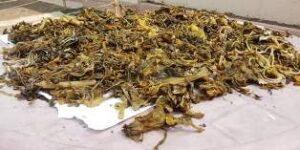

Kandruk or Gundruk
(vi) Khareng (Limboo) Selroti (Nepali)
Khareng or Selroti is a cereal based fermented food of the ancient people of the Himalayan region and has Limboo mythological connotation as described under Limboo festival of Balihang Tongnam as follows:
Until today, the people who go to celebrate the occasion are usually given cash gift and some people used to give edible items as well. The best edible items during this occasion areKhareng (selroti). Therefore, theLimboos even today feel that this item is best known and mandatoryitem andevery one of the household prepare this item by any means. The most significant part of this celebration during the third day of occasion is to pray and offer good food and traditional flowers for wellbeing of the brothers by their own sisters.


Rice, Millet four khareng (Limboo) Selroti (Nepali)
(vii) Wamyuk
Wamyuk is an important traditional food of the Limboos. It is prepared from burnt chicken’s small feather and wings and other parts. For this, the chicken should be cleaned, killed and its small feathers and wings are burnt. These burnt wings and feathers are collected in a plate for preparation of “Wamyuk”. Chickens heart, liver, head, intestine are washed and mixed with other ingredients and prepared accordingly. This item is preferred to be eaten by the Limboos with millet beer and alcohol in any of the occasions.


Local chicken for preparation of Wamruk & the item -Wamruk
DRESS, LIMBOO TRADITIONAL COSTUMES
The dress culture or costumes of the people of Sikkim have a tremendous diversity, divided in to various communities living in Sikkim. With its most colorful diversity and pattern also link Sikkim to the history, culture and identity of its own in the country. Different communities have their own traditional dresses symbolizes commitment to their distinct community, identity and culture. The Limboo community, being a distinct ethnic tribe has its own dress culture in Sikkim.

A woman traditionally adorned with ornaments – Chaptey-Sun, Dhungri, Bullaki, Kalli, Rayji, Potey-Mala, etc
Most of the traditional rural folk dress of the Limboos from antiquity is Dawra Sruwal, Pattuka, Thutey Suruwal, Dhaka Topi, Waist Coat, Galfan Moza and Laber ko Jutta. They may also wear ornaments such as Sirupatey Khukurie, Suna ko Authi, Suna ko Chain and Suna ko Aunthi. Most of rural Limboo are dressed in Fariya, Chaubandi chola, Hembari, Mujetro, Pattuka, Moja and Lber ko jutta. They may also wear ornaments such as Chaptey-Soon, Dhungri, Bullaki, Kalli, Raji, Potey-Mala, Aunthi etc. these dress are in vogue in rural areas since antiquity.
(i)Head Regions- for males
Paga: The traditional costume of male for head region of the Limboo community is paga (Turban or Pheta in Nepali). This is based on Mundhum (oral tradition) – Ponlung Leppma (origin of Nahangma sam or chotlung) of the Limboos. The Limboos have unique form of performing prayers for their origin, which is called “Nahangma” a symbol of power, prestige and progress of human being. The myth has also expounded that, the use of Muden Phe (knife) or sword honoring the guests with “Paga” (pheta or turban)sincethen, which was in practice in our society. (Kainla Bairagi 1993, Shreng Rana Dhoj 1992, 1993 Subba C. 1995 1-284; Subba J.R. 1998; 1-18 1999; 293-209). Thus, Paga costume of the head region of Limboo is a prestigious and was used for elite Limboos only. It consists of one to one and half-meter white cotton cloth. Now a day it has also been made as a readymadepaga, but it is yet to be popular. In case of Limboo priest Samba, Yeba (both males) and Yema (female), it is made of white and red colored cotton where Wassang (feather arrows) sewn. Now a days, this paga has been used by Limbbos in special ceremonial day or any occasion of programme to the guests who are special one as a mark of respect and honor.


Different types of Paga -Turban or Pheta

Muyesup: Then, there developed Thak – khuk or Muyesup as head region costume for common peopleof the Limboos. It is a cap with white and other colour clothes too like that of paga in the beginning. Now-a-days, most of the Limboos use colorful caps as it is easily available in the market. There is a customary to wear and distribute Topi or Cap during the final death rituals of the Limboo community since antiquity.
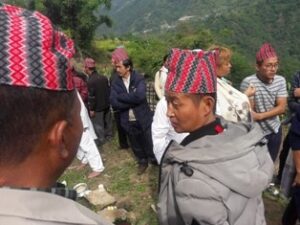
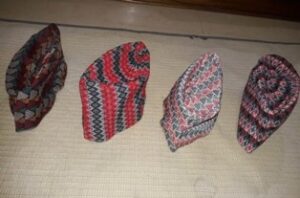
Different types of Paga -Turban or Pheta
(ii)Head Regions- for females
Thakumay:The common traditional costume of the head region oftheLimboo women is Thakumay. We find the description of this costume in Mundhum of Yuma Sammang. She is suppose to wear white Thakumay,and revered as the daughter of the Almighty GoddessTagera Ningwaphumang or Yuma. She (also known as Yuma Sammang or Yuma only is also considered as the early form of universal Almighty Goddess. She is suppose to have the equal power and grace as that of Almighty Goddess, and thus the Limboos pray every morning and evening the Yuma only. It is seasonally prayed with newly harvested grains, fruits, roots and tubers even with animal sacrifices for worldly peace and comfort mainly at crop-harvested time.Thakumay is made of white cotton cloth of about one and half meter length and one-meter breadth. All class of Limboo women as head costume uses it.

Thakumay a common traditional costume of the Limboo woman
Pothang: It is just like that of Thakumay, but bright red colour cotton cloth used specially for bride and groom at the timeof Mekkam ritual of marriage. This is an essential costume of Mekkam Thim (Lagan in Nepali) ceremony of marriage of Limboo.
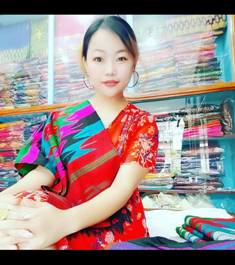
A young Limboo girl wearing Pothang or Shawl
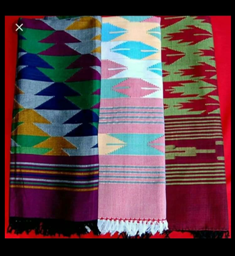
Pothang or Shawl
(iii)Head Regions- (both gender)
Ningkheng or Galphan: the traditional costume of the neck region of their body made of green, red and yellow colour woolen thread (hand woven). The costume is in vogue since antiquity, specially young people when performing traditional dances like Yalakma, Chyabrung, Khyali etc. we do not have any traditional costume for women in the neck region. The Limboo women used Thakumay or Pothang in the neck region.
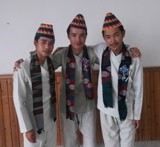
Young Limboo boys in traditional wears with Ningkheng or Galphan

Ningkheng or Galphan / Scarf
Upper Body- for male
There are a number of traditional costumes for the upper region of body for both men and women. They are (1)Sardokpa (2)Pagappa (3)Paohoa (4)Suthekwa (5) Lappeta Dawra (6)Laoghek. these six types of traditional costumes of main body are the general dresses of the common Limboo Man develop from the primitive single-piece-dress known as “taga”. They are made of cotton in the beginning but later on adopted polyester and nylon with multi-color tied with two to four and more pairs of Changnam or (tuna in Nepali).
(7)Hangchang:In the Limboo language, Hang means the King, and thus Hangchang is the royal dress of the elite people or the king. In the beginning, it was made of white cotton, but later on switched on to polyester, woolen fabric of different colours. The dress is also developed from primitive dress “taga” for the elite people .it is vogue and often seen being worn by the elite people.
(8)Sunghreba (coat type), Ascoat (waist coat), Suthekwa (coat) and Aalphi (shirt): These costumes were adopted by the male folk of Limboos after they come in to contact with the western people specially with the English in the later Eighteenth century to early period of Nineteenth century. However, these costumes are vogue in both rural and urban areas of Sikkim, but considered not their traditional costumes
Upper Body- for female
(1).Sunghamba (2) Chungloghek (3) Chaubandi: These three general main body traditional costumes for the women folk of the Limboos are developed from the primitive-one-piece female dress known as “loghe” in due course of time. It is made of white cotton’ later adopted to different colours of cotton, polyester and woolen clothes tied to the body with or without four pairs of chungnam or stitched as a single chungnam. Sunghamba is for the unmarried girls and is without Chungnam. Chunglighek and Chaubandi are for the married women and are most popular. These costumes are in vogue both in rural and in urban areas today. They are easy to wear, easily available, adjustable in tightness in the body with help of four pairs of Changnam or Tuna, and hence named Chaubandi Choli.


The Limboo women folk in traditional desses Chungnam.
Chungloghek and Chaubandi
(4)Mekhli: it is a Bridal Dress of Limboo woman, usually made of red cotton and also developed from “loghe”. Now a days it is made of different types of fabrics depending on the material available.
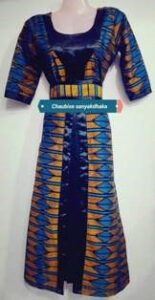


Modern designable Mekhli
Waist region
Phayee: made of white cotton cloth 2-3 meter long, tied around the waist region by both the gender. Now a day it is made of different colours (mostly red and yellow) and other fabrics.
Yuppen: it is modern leather or foam leather adopted by Limboo man folk. Although, it is in vogue, not considered as their traditional garment.
Pangphayee: a wide belt of reed cotton is worn by the religious priest Samba, Yeba (male) Yema (female). It is the essential gear of the mystic priest. It is worn only during the mystic functions Samba, Yeba and Yema.

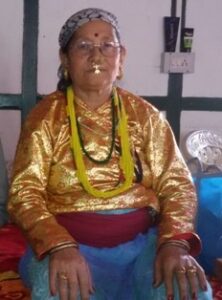
Wide belt (Phayee) used by both gender of Limboo community
Lower Body Parts
For Males
(a) Jangsumba and (b) Sumba or suruwal: these two types of traditional costumes for the lower body part of the common man-folk of the Limboos developed in due course of development in the ocld climate of Himalayas. These are made white cotton. Now a day, it is made of various colours and fabrics such as polyester, woolen etc. these traditional dresses are in vogue both in rural and urban areas of Sikkim.
(c) Hangpen: Royal dress used by the Hangs (Kings) but now, being used by all elite Limboo man-folk. It is like that of Sumba or Suruwal; but made of different fabrics and better in quality as that of Jangsumba.
(d) Simna or Yesim: it is a log-pleated robe, held at the waist by a strip of cotton passed through a hem-like belt. It is usually white, pleated, and decorated with two white horizontal bands; on at the levels of thighs, the other at cave’s level. It is an essential gear of religious priest—Samba Yeba (all males) Yuma (female) and Yema (female). They wear it during their mystic dances of Tongsing, Phungsok and much such religious ceremony.


Simna or Yesim- worn by Phedangma the Shaman Priest of Limboo
Langsup-Ladhop (shoes-stockings) (f) Huksuppa (hand gloves): Although these costumes of both sexes are in vogue today, the Limboo consider these costumes of recent adaptation.
For Female
sim or Gunneu: These are traditional Limboo costumes of the female folk made of cotton and various colour and all other fabrics. These are sometimes almost like that of Lepcha costume but differ in length and on the way of wearing. Now it is made of various colour and fabrics—polyester, woolen, silk etc.
Saya: It is non- traditional dress of Limboo women, adopted recently. It is made of cotton and used inside sim or gunneu.

An old woman with traditional clothes -Sim or Gunneu
LIMBOO TRADITIONAL ORNAMENTS
Ornaments for Males
(i) Ear Ornaments
Gokul: Earring made of gold and silver. It is rarely worn these days.
(ii) Teeth Ornaments
Hebo Samyang: Gold nails pegged on the front teeth (two or more in numbers).
(ii) Necklace Ornaments
Namloyee: A necklace made of silver. It is very common necklace worn during marriage, Tongsing worship etc. it is exclusively a Limboo traditional ornament. It is also known as Chandrahara (in Nepali).
Sikri: Chain made of gold or silver it is rarely worn these days.
(iv)Hand Ornaments
Hukpangee: it is made of silver known as Chura (in Nepali). Now it is rarely worn.
Swakep: Finger rings made of gold, silver or brass. Gold rings are common today.

Hukpangee , Bangles

Swakep, Ring
Female Ornaments
(i) Ear Ornaments
Nessey: it is called Chaptey Soon (in Nepali) made of gold it is very common.
Terengna: it is made of silver, Limboo believe it to be their traditional exclusively.
Laskari: it is an earring made of gold.
Kanthungri: it is also an earring made of gold. It is in vogue in present.

Nessey – Chaptey Soon

Kanthungri

Nuruka or Marwari
(ii) Nose Ornaments
Thungri: it is made of gold and very common in rural areas.
Nebophung or Thungri: it is made of gold and very common in rural areas.
Pholaki or Mundri: it is also made of gold and common.

Nebophung – Dhungri

Pholaki or Mundri
(ii) Teeth Ornaments
Hebo- Samyang: Gold nails pegged on the front teeth (two or more in numbers).
(iv)Forehead Ornaments
Samyangphung: which is called Shirbandi in Nepali a combination of three bigger size chain it is forehead traditional ornament made of gold.
Namphung: which is called Shirphul in Nepali Plate like forehead traditional ornament made of gold. It is an exclusive ornament of the Limboos.
Laghekcho Sikri: which is called Shirbandi in Nepali a combinations of three parallel bigger sizes Chain, resembling shape of the half moon with Star. it is also a forehead traditional ornament made of gold.
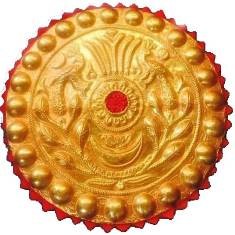
Namphung Shirphul

A lady adorned with Namphug, & Laghekcho Sikri
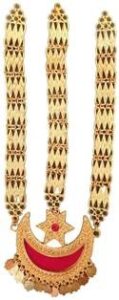
Laghekcho Sikri
(v) Necklace Ornaments
Hasuli: A kind of necklace made of silver. It is very primitive type of ornament, not in vogue.
Namloyee: it is made of silver most common necklace of Limboo women. It is an exclusive traditional ornament of the lImboos also known as Chandrahara (in Nepali).
Samyang Patche or Kantha: it is made of gold commonly worn by rich women.

Namloyee/Chandrahara
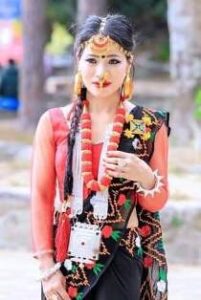
Limboo lady decked with Namloyee, Kantha & other ornaments
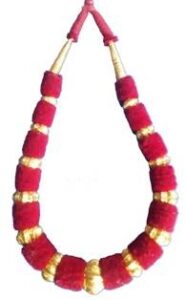
Samyang Patche/Kantha
Simikla Hari: it is made of hollow high-altitude bamboo internodes beads (Simikla).
Pongwarior Kanthui: it is an exclusive traditional ornament of Limboos as it has been elaborate in Mundhum, connection about the Sun-light and thus essential requirement during Tongsing worship ritual. It is also called Pangwalo (in Nepali) made of red coral beads. The bead has been found still in some parts of the village used by the elderly women folk as an ornaments which is being treated as one the traditional ornaments among other.
Mekkhim Pona: It is called Tilhari in Nepali, it is made of gold very popular ornament in rural areas, but considered later adopted by the Limboos.
Sikiri: it is made of chains of gold or silver. It is also very common in rural areas.
Panaye: it is Potey Mala (in Nepali) made of colourful plastic or stone beads. It is very commonly used by married women, but considered adapted later by the Limboos in their marriage culture.
Kantha: it is made of gold commonly worn by rich women.
Bahi: Plastics or bamboo bangles.
(v)Hand Ornaments
Hukpangi: it is Chura (in Nepali) made of gold or silver.
Bahi: Plastics or bamboo bangles.
Swakep: Anguthi or finger-rings made of gold, silver or brass.
Mundro: Finger rings made of Aluminum.
(v) Leg Ornaments
Langpangi:It is Kalli (in Nepali) made of silver.
LIMBOO TRADITIONAL DANCE AND MUSIC
Folk culture refers to the localized life style of a subsistence or otherwise inward looking culture. It is usually handed down through oral tradition and has a strong sense of community and values the old ways. The section of folk culture of the Limboos comprises of Folk Dances, Folk Musical instruments, Folk music, Folk Songs and Folk Tales. The performing arts of the Limboo Community combine Folk song, folk music and Folk Dance of the Limboos. Many performing arts such as folk songs, folk music, folk dances folk musical instruments associated with Limboos and other communities are disappearing with the passage of time along with older generation people day by day. The state Government of Sikkim is tying its level best to promote eco-tourism, village tourism, adventure tourisms etc. in which this type of performing arts has got major role to play. The civic group such as Sukhim, Yakthung, Sakthim, Phojumbho, Tharpu, West Sikkim, holds annual celebration on 23rd August, every year and provide an important performance venue for exploring cultural potentialities.
Ceremonial Dances
There are two kinds of ceremonies, religious and social. The religious ceremonial dances have ritualistic overtones and are celebrative in character, while some of the dances have fascinating character or symbolism, others are only celebrative important religious occasions (Pani, 2000;28) the Limboos Sewa Samlo while dancing with Ke-lang at the time of house warming ceremony falls under this category ceremonial dances.
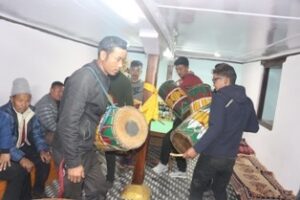
Kay Lang – ceremonial dance for House warming
Yialakma
Yialakkma (Dhan Nach-khas language) is the most popular dance among the Limboo community. It is a harvest dance teenagers to late adults of both sexes participate enthusiastically. The dance is usually organized at night during the paddy harvest seasons in the early ages. However, with pace of time and depending on the availability of youth in the particular locality the occasion of such dance is organized in different occasions. The dance disorganized mostly during the festive seasons like marriage, death rituals, New Year’s celebrations, traditional ceremonies, fare and melas, haats and any occasion of entertainment. Moreover, an exclusive program was organized and meeting together venue like Bazar, haat sheds, waiting sheds, centrally located were fixed as per convenient of both parties, this kind of organized program was seen where maximum youths were engaged for performing as the source of entertainment in the locality.

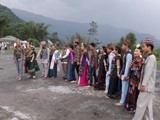
Social Dances
Extreme happiness calls for a celebration, dance and celebration go hand in hand. Human beings are essentially social. There are some events like marriage and birth of a child celebrated with great happiness, it is celebrated not only by family members but by the entire community living together in the village. Therefore, marriage and childbirth are celebrated by all members of the societies and sharing of edible food items as a token of gift while attending the celebration is very common. There is yet another kind of social dance in which unmarried boys and girls choose their partners. This type of dances will also falls under this category (Pani J. 2000;62). Such Limboo dances are Yalakma, Kay – Langma etc. which has or will be described under different types of dances in this topic.
Seasonal Dances
Seasons are closely connected with agricultural operations. Since agriculture is the main stay of the Limboo people of Sikkim, especially those living in rural areas, seasonal changes are great importance. Majority of folk dance form can be seasonal because they are said to be performed in seasons. For instance, all harvest dances are seasonal. But, under this sub—heading those dances will be discussed which performed to celebrate or welcome the seasons.
Tamkey Okma or Tam Okey
It is a seasonal dance of the Limboo community. Which is performed at the time of maize first earthing-up operation during pre-monsoon season of Chait-Baisak. Tamkey Ookma (means digging with melodious song singing with partners- girls and boys in Limboo Language) is performed in the open maize field and song sung during the occasion is same like that of Pallam song during Yialang. The same partner who usually performs Yialang would be the best competitive partners during this Tam Ookay performance too but differs the melodious tone of singing. The tone of song is quite lengthy, slower, melodious than that of Pallam song which is sung during Yialang or paddy dance. During this Tam ookay performance the individual partners take Spade and stand each partners earthing-up of maize crop is done in consonance with the motion of song, reply, and counter reply of the partners in the field. The melodious song leads to love song as well depending on the emotional imagination and inner feelings of the partners.
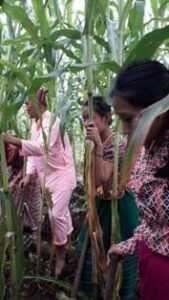
(Tam – Okay pein one of the village of West Sikkim)
performed in real life situation at Maize field
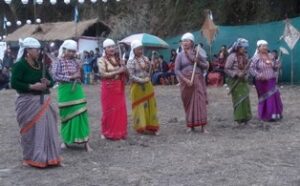
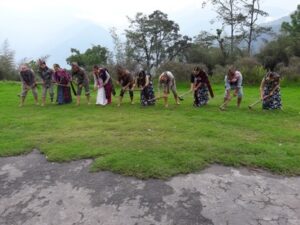
Tam – Okay performed as dance form by different Limboo Artists
Drum Dance
Most of the Limboo dance require drum accompaniment. Generally, the drummer provides the percussion accompaniment with dances. There are many dances in which the dancer himself plays the drum while dancing. Such dance comes under the drum dance.
Kay Lang or Chyabrung Lang
Kay Lang or Chyabrung is one of most popular drum dances of Limboo community. This dance is found to be most attractive and well known by many other community in Sikkim and other neighboring state as well. The dancers consist of several numbers of males and sometimes with each female member are seen dancing with bodily actions in between each males and inclusive of all, the number of participants ranges from 6 to 20 and even more.

Kaylang group, stage presentation
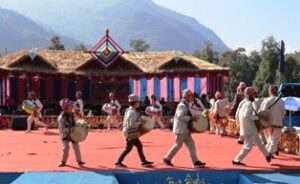
(Kaylang group welcoming Marriage ceremony)
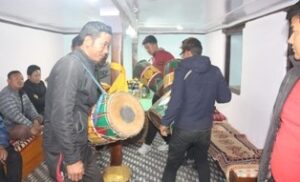
(Kaylang a ritual practice Thok-thamma, on the occasion of House warming)
Limboo Folk Musical Instruments
Sikkim is very rich in folk musical instruments but very difficult to trace the first musical instrument of the state, because the primitive people all over the world seem to have made music of some sort. Folk music exists in space not in time. According to the myth of Mundhum of Limboo community, the first musical instrument was a bamboo harp known as Simikla Kom (Binayo in Khas Language) made for their sister Tetlara Lahadongna, made by the sons of Sawa Yukphung Kemba, namely-Samdang Khewa and Lungdung Khewa for their sister Tetlara Lahadongna in antiquity. The myth says that the next instrument was Niyara Hongsing Kay of Lokpha Temba and Hongpha brothers who danced around the new house to protect the newly constructed house from the evil spirits. In another myth of Mundhum, it is also said that Samba, Yeba, and Yema Limboo mystic Shaman priests came to the village of Sawa Yethangs the primitive dwarf men with their gear Yegeysing pole tied with Niyara Hongsing Kay to drive away the evil spirits from the villages. Similarly, there are a number of myths about the origin of musical instruments amongst the different community living in Sikkim in antiquity. (Subba J.R.1999; 203:204; 2008:195; 2009:198-354).


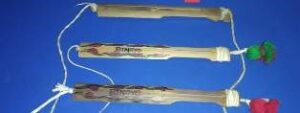
(Simikla Kom, Bamboo harp)

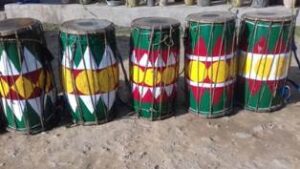
(Niyara HongsingKay – Cyabrung)
Negra (Kettle Drum)
”Nagara” is a royal musical instrument having the right of royal honor. The ownership of this drum has special character and certain conditions, this drum ”Nagara” could not be owned or possessed without the explicit order of the competent authorities the then Royal of Sikkim. It is said that, the fact behind this set of drum (Negra) was given to a very few well known and prominent members of Limboo communities along with a written Document called Lalmohar and the set of drum was treated as a common asset of the particular clan and usually inherited by the eldest son of the family. Thus granting of permission to to possess this drum has its own significance. The Lalmohar (a written document with red seal) categorically empowers and enables the concern clan of the community to live with full dignity and honor as a Bonafede citizen of Sikkim during the reign of the king or Chogyal of Sikkim.
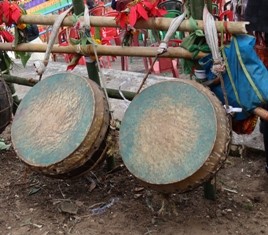
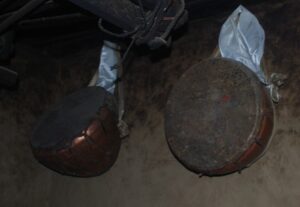
(Negra (Kettle Drum) owned by Bonafede people of West Sikkim)


(Young experts the limboo boys playing Negra during festival and marriage ceremony)
This drum is used in almost all occasions of celebrity and sorrowful moments like death, funerals and last rituals. However, the event of celebration can be clearly understood through beating of the drum, the beating differs in each occasion. Usually, the drum cannot be prepared and even for changing of the skin; certain mystic formalities are required to be follow. The ownership of the drum Nagara can’t be changed rather it would be transferred to first legal heir of the family with certain roles but under no any circumstances the owner is allowed to give anybody. The owner of drum Nagara is socially obliged to keep the drum all time well maintained as a Royal ornament for all members of the clan and sub-clan. The tune of the music from the drum signifies kind of event taking place within Limboo community.

(Negra beaten at the time of cremation of body)
Limboo Folk Songs
Different communities of the state have different folk songs, which are generally disappearing, or being replaced by Hindi pop songs, English pop songs or other modern forms of songs etc. some of the important folk songs of the Limboo community are as follows:
The Limboo community is very rich in folk songs. Their folk songs have been divided in to five groups namely:
Khyali- Dialog songs where the young boys and girls express their day-to-day romantic feelings, views on poetic language with tune.
Love songs-
Sordokpa Pallam samlo
Pallam samloand
Tamkey Ookma Pallam samlo
In all the above, they sing love song by the young girls and boys while in dancing or working and provide a forum of courtship for marriage. The song may continue a few hours to several days and nights continuously.
Hakpare Samlo- Gentlemen and women song, which is sung in special festive occasions by the elder people for entertainment. This is most exciting and entertaining for elderly members of Limboo community.
Nisammang Sewa Samlo- Ceremonial songs sung in special festive and worship occasion by the young boys and girls;
Kay-Lang Samlo- song sung while dancing kay lang on special occasion or for entertainment while performing kay lang by both young boys and girls.(Subba; 1999:203-213).
In addition to this, there are many songs related to agriculture, war, historical etc., which are not popular in real life situations of Limboo society, but often, observed in special occasions organized by different cultural societies in the cultural stages only. Limboo cultural Society of Tharpu, West Sikkim has been doing a lot for preservation, development and dissemination to conduct such performance of folk songs and dances of Limboos in various place of Sikkim.
Pallam samlo: It is a most common folk song of the Limboo and has been beautifully described by C. Subba in his book (1995). When the young men and women participate in Yalangk dance, they sing almost in the form of competition and usually the individual try to excel the partner while singing/dancing. The song is invariably sung on the theme of Mundhum, entertainment and love. The oral, extempore singing of this song requires creative, imaginative and poetic thinking. The song indeed requires immediate reply of the queries of the partner and he/she often tries to impress the partner with excellent composition, reply and suitable/melodious tone. Though there maybe long queue of persons participating in the Yalangma by holding hands by men and women in a circle or line, no individual who have Blood Relations of not less than Three Generations are allowed to hold the hands of any opposite gender and whatever may be the queue the main.

(Limboo men & women folk participates in the Yialangin marriage ceremony singing melodious Pallam Songs)
competitor for singing shall be the two boys and girls who are socially permitted to dance with the particular boy or girl in a circle. However, any related male to male and female to female are allowed to hold the hands and help in singing chorus and dancing process.
LIMBOO FESTIVALS
Festivals or Utsavas or Chaar means celebration of certain occasions and delivering one at the higher mental state. This includes the festivity, marry-making, celebration of anniversary, commemoration of occasions, observance and honoring of certain moments etc. Most of the Utsavas are therefore, associated with some conventions, customs, traditions and rituals. Modern thinkers define an Utsava or festival’ “it is ritual as a symbolic enactment of myth, all rituals performed at the time of holding an utsava and have symbolic myths behind them which signify meaningful and integral part of the convention of the particular community”. Sikkim has a number of different festivals that range from domestic events or ones focus on local shrines to great state holidays.
The important festivals celebrated are –
Balihang Tongnam (Tihar)
Amongst all other festivals of Limboo community, the “Balihang Tongnam” (Tihar) is regarded as one of the most significant celebration or festival. The mythological reason of this festival is most significant than any other festivals and Limboos residing anywhere, any part, and any region of the country or world celebrate this festival with tremendous enthusiasm and happiness.
Seasonal Festivals
Apart from the main festival of Limboo i.e. Balihang Tongnam, there are series of other festivals which are traditionally scheduled throughout the year. Most of the festivals are clubbed in the winter season and in the spring time. Spring festivals correspond roughly with the conclusion of the winter agricultural season and then beginning of the hot season. Winter festivals mark the harvest and offering of the newly ripened food grains to “Yuma Mang”, Almighty God for pleasing and satisfying her to bless in the days to come. The winter session being comparatively relaxed time after harvesting the crops, the inhabitants feel free and thus this particular session is utilized for wedding and attending fare, melas, pilgrims, inviting and visiting in-laws, relatives and other celebrations. Therefore, the Limboo community arranges wedding parties during this winter session and till date the convention is being maintained. The best seasons for celebration of festivals are either the beginning of winter season or beginning of the summer season as well as mid- winter and mid-summer season. Thus, the best well-known Limboo festivals are Bali Hang Tongnam, Kokphekwa Tumyen (Maghey Sankrati), Sisekpa Tumyen (Sawaney Sankrati), Chasok-Thisok, Yumang (Yokwa), Tyeongshi Srijunga Sawan Tongnam, Tapfeng, Tongsing, Phungsok etc.
Chasok-Thisok (harvest festival)
“Chasok-Thisok” is a celebration to offer the new food grains, fruits, root and tubers and other agricultural products to the gods and goddesses when they get ripe or is ready for harvest. It is a harvest festival and celebrated individually or collectively. The supreme Goddess Yuma Mang is worshipped through her worldly form Yuma Sammang ceremoniously for her blessing with various crops and animals for cultivation and rearing respectively. They believe that Yuma Sammang gave these crops and animals to them for survival and thus they offer and sacrifice the first harvest of the crop and the first progeny to Yuma Sammang, and celebrate as Chasok-Thisok festival (details described under Swaney Sankrati). They offer newly ripened food grains, fruits, roots and tubers etc. and also sacrifice the first progeny of the domestic animals (pig, fowls) etc. Traditionally, various kinds of animals were used to sacrifice to appease her during this worship ceremony and sacrifice was compulsory. However, the sacrifice of animals was discouraged and currently the use of animals sacrificial is comparatively less. This offering of food grains is conducted in every household of the Limboos. Practically, the first harvested foods like paddy, millet, wheat, barley, buck wheat, roots and tubers like greater yam, sweet potato, cassava, colocasia, ginger, turmeric, garlic, cardamom are restricted to put in the mouth, in case of putting without offering as usual the physical suffering would be felt as a mark of punishment. Similarly, one female piglet needs to be successful piggery. Therefore, offering of these food grains, root and tubers spices and also piglet, fowl as Samdangwa Karangwa, finger millet beer, husked rice grains, beaten rice (Sambek) is must and Limboos compulsory do this and treat as festival. The festival is celebrated during the time of ripening of food grains.
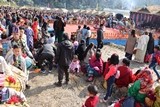
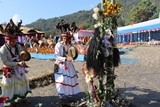

(Celebration of Festival – Chasok Tongnam)
Kok phekwa La-gaenge (Maghe Sankranti)
The Limboos follows Yalamber Calenderand as per this calendar the first day of the Limboo New Year falls on 14th of January and which is regaded as the New Year Day of Limboos. This day is known as “Kok phekwa Tumyen” the New Year day is celebrated with full of joy and happiness. This celebration welcomes the most prosperous and happy New Year. The New Year day of Limboo has the mythological origin.
. On this day, Sammangs specially Tap Sammang (Kuee Kudop – Mundangwa Sringwa, Tenchama, Khanjoma, Wajanma and Toksangba) propitiated worshipped with offering of roots and tuber crops, even with blood sacrifices of fowls etc. after taking bath at the confluence of River like Teesta and Rangeet River, symbolizing the meeting of human beings and Sammangs (divinities) while in life and beyond. After all, the man has to go back to his place of origin- physical consciousness and then spiritual consciousness (to join the mangs and the sammangs after his death living his physical body on earth.

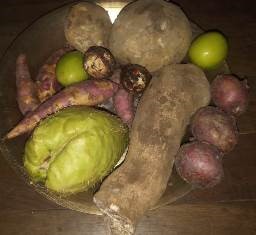
(Different types of Roots taken at the time of Mangey Sangranti)
Nevertheless, with the pace of time the system of celebration of this ‘Kak Phekwa Tongnam” is shifted to the premises of Mangheems. Currently, the celebration is being made in the premises of Mangheems and most appropriate venue is regarded as Mangheem only. During this day, tubers such as Ban Tarul, yams and a varieties of greater yams, sweet potato, roots Iskus, Simal tarul (cassava), colocosia are collected. In earlier days Limboo boys and girls used to assembled in the venues two to three days advance in the festival and used to perform paddy dance (Yialangma) for the entire week or so, and providing the forum for love making and elopement or selection of their life partners. Now, exhibition of Government Departments are organized at Jorethang South Sikkim and the people enjoy the exhibition side by side. The Sikkim Government organizes Cultural program for the people who come for taking Makar bath at Jorethang. (Subba J.R. 1999;198;2008:217;2009:313-321).
Tyeongshi Sirijunga Sawan Tongnam
The birth anniversaryof “Tyeongshi Srijunga Singthebe”, theincarnate of the king Srijunga Hhang of 9thCentury, who had codified the Limboo script now known as Srijunga Script is celebrated as festival by the Limboos of Sikkim. Tyeongshi Srijunga Singthebe (1704 to 1742) singly credited for revival and propagation of reading and writing Srijunga script in Sikkim. In the process of propagation, he came to Martam, West Sikkim in 1730, and started propagating Limboo Language and Literature. While he was propagating Language and script the was assassinated in 1742, and he sacrificed his life for the cause of the Limboos. However, he has been survived by his committed work of propagation and he could create a towering figure in the history of Limbolanguage and literature. The Limboos feel proud of his sacrifice and assassination. This day falls in the month of December Senchrengla Labhoon (Mangsirey Purnima), on this ay The Government of Sikkim has been pleased to declare Govt. holiday. This declaration was made in 1997 as a mark of respect of sacrifice of “Tyeongshi Srimjunga”. Of late, this day of celebration become popular to all Limboo community living in Sikkim, West Bengal, Assam and Nepal. The celebration is to commemorate the birth anniversary of great soul and celebrated in various places.
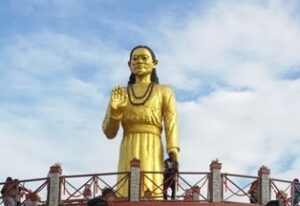
(Satue of Srijunga at Hee-Yangthang, Maneybong – Dentam West Sikkim)

(Satue of Srijunga at “Srijunga Mangheem” Martam – Bermiok West Sikkim)
Iman Sing ChemjongSawan Tongnam
The birth anniversary of Iman Sing Chemjong (1904-1976) the great historian and Limboo language expert ps celebrated festival in his honor by the Limboos in recent years. In Sikkim, the festival is organized by Sukkhim Yakthung Saplon Chumbho, west Sikkim every year since 1997. The Literary organization was started for the development of Limbooo language and literature in 1995, and was registered officially in 2000. Annually, literary competition on Limboo poem, essay, stories, and drama etc. are held on that festival, and winners are awarded for the promotion of Limboo language and literature. The language and literary articles collected thus are edited and published in annual journals known as “Emeytnasung“. So far, 40th issues have been released by 2017. A number of books, journal, magazines on Limboo language and literature are also released on the day of festival. Cultural programs like Yialang, Khyali, Hakparey, Chyebrung, etc. are held. In this festival awareness program of the Limboo community takes place in general

(Celebration of birth anniversary of Lt. Iman Singh Chemjong at Gayzing West Sikkim)
Pilgrimage
Many Limboo people of the older age of all faiths go on pilgrimage every year. Some go to visit the birthplace of their religious priests, work place like Yasok, Burasubba, Nepal, Martam in Sikkim and other holy places for mental and spiritual satisfaction. Other set out to earn merit, fulfill a vow, or seek a boon for deity. A pilgrimage may be as simple as an extended trip to a nearly shrine or as complex as journey that traverses much of the sacred spaces in the state or the country. Usually, the Limboo have tremendous faith on origin of ancestors place and this is known as Mangenna Lungdhung or Mangenna Yiok by the Limboos, the birth place of particular Clan or sub clan(thar or sub-thar)of the Limboo. Limboo treat such birthplace as most meaningful and holy pilgrimage. Pilgrimage lifts the pilgrim from everyday life as the individual travels to a sacred crossing. This period of pro longed contact with the religious teachers as pilgrims halt at shrines, such as Mangheems, and enjoy teachings by religious teachers, blends seamlessly with tourism. The pilgrimage also provides forum for interaction with diverse group of people.
LANGUAGE AND LITERATURE
Sikkim state has rich socio-cultural source with multi-lingual of different ethnic groups with its mother tongue or lingua franca called ‘Nepali’ the language that has been recognized and enlisted under 8th schedule of Indian constitution. The Lepcha, Bhutia and Nepali languages have been recognized by the state Government as official languages in the year 1977. The Limboo language has been given status of official language by the state Government in the year 1981. Further, during the year 1997, seven other languages have been given the status of official languages and thus all together eleven languages have now been accorded official languages in the state of Sikkim.
Historical written record reveal that, during 9th century A.D. the king popularly called as Srijunga Hang invented/devised a script of Limboo language which is of late known in his honor “Srijunga script”. The design of the script resembles as script through blueprint copying of the Brahmi script of the Gupta period (4th to 8th century A.D.
The letters of the Srijunga script are comparable to the Gupta Brahmi script, later;Srijunga Tyeongshi(1704-1741) revived and popularized Srijunga’s Script. A number of photocopies of practicing writing system while teaching the Limboo people at Martam, West Sikkim are evidence of his work, safely preserved in the office of Indian Office Library London. There was no addition or deletion of letters to the “Srijunga Script” during his period.
Limboo Language Developments
The policy of educating more and more about its own state and culture to the students of Sikkim could not be successful as desired even today, because of absence of its own Board of Education. Now the Sikkim University is trying its level best towards this direction since 2007. From the Linguistic point of view, this is the movement away from Tibetan and Nepali to the regional vernacular languages, emerged from ancient oral Literature to written forms, stimulated by the integration of the Sikkim in to the Indian union as the 22nd state of India. The Government of Sikkim through the Sikkim Official Language Act, 1977 recognized Nepali, Bhutia, Lepcha Language as the Official languages of Sikkim, the Limboo language got status of state official language only in 1981. The Graduate level classes were started in the year 2000, under NBU, and the Sikkim University formally started the classes from 2008 respectively. Now, in this current stage the Ph. D Courses has also been started from the year 2022. It is because of rapid Limboo Language development the Limboo Language along with Bhutia and Lepcha Language, got recognition from UGC for the permission to teach in the Master Degree level from the year 2016, now, which is being executed and run in the Sikkim under Sikkim University.
Limboo Literary Association (Sukkhim Yakthung Sapsok Sangjunbho) was registered in 1979. Numerous Limboo folklores, poems, essay, novel etc. have been published in Sikkim from time to time. The prominent Limboo writers are B.B.Subba, Padam Singh Subba, S.R. Khajum, Jas Raj Subba, Mohan Prasad Subba, Bal Bahadur Subba, Lt. Mohan Subba (Ijam), Lt. Chandra Mangyung Harka Bahadur Khamthak, Dr. B.L Khamthak and many other school Teachers. Srijunga script was computerized in 1995, (J.R.Subba, 2002; 2008; 159,178; Subash Deepak, 2014).
Religious Traditions
“Yuma Samyo” Yumaism is the religion followed by the Limboo community.
Yumaism is a Henotheist or Kathenotheist religion and believes in a single Almighty Goddess “Tagera Ningwaphuma” which is also popularly known as “Yumamang” while still recognizing other gods and goddesses created by her, as her Messenger or Her manifestations who helped Her in the creation of universe, earth, planet, the entire living and non-living things and its preservation, sustenance and development. Tagera Ningwaphuma is the ultimate supreme Goddess, omniscient(all knowing)omnipresent(in all places at all times) omnipotent (all powerful) infinite (without beginning or end) and eternal force light or power of existence which has none of the attributes. The basic concept of Yumaism is that, the Tagera Ningwaphuma created the universe including every living and non-living things in it with the help of her messengers, collectively known as Mangs (Deities). Sheis there in everything of Her creation. Yuma Mang or Yuma is the creator, the preserver, the sustainer and should be prayed every morning and evening to establish close relationship with Her by the Yumaism adherents.
The Worship place Mangheem/Mangdhans of households
The Almighty Goddess Tagera Ningwaphuma is the only Goddess who is revered most and whose names referred in the direction of several times and several places. A number of other Gods and Goddesses are also prayed for blessing and success for their respective role of occasion in assisting the Almighty Goddess Tagera Ningwaohuma in the creation of the universe, all other gods and goddesses are her messengers (Sijo-ingmi Sa).
Construction of a collective worship place known as “Mangheem” for the Almighty Goddess Tagera Ningwaphuma in its “Mang”(Deity form at “Mangheem” has also been started in many places from the last quarter of 20th century. The Mangheem comprises of Eight Steps on the center of the Mangheem inside, tapering on the top representing the Eight Atmospheric layers of the earth (Eight Dens) each considered as a separate realm or world or Den of the mother earth atmosphere known as “Sangbhe”. The ground floor is considered as the living world (Iksha Khambek Den). The Mangheem of the outer structure comprises of three layers plus Five cone “Star” at the top or apex (Gajur), representing nine Dens/world/realms (tal-atal) (3+5+1 ground floor) again of the earth’s atmospheric layers inclusive of Iksha Khambek Den. The Mangheem looks typically of the Yuma samyo due to its architectural identity.
The religion does not believe in idol worship. The adherents pray and worship the Almighty Goddess Tagera Ningwaphuma in its Yuma Sammang (Yuma Sam) form as a physical consciousness or as Her daughter (Divinity/Sam/Soul/Incarnate form) in every households, with a simple flower vase with Artemisia Vulgarize flowers twigs. The Goddess is prayed every morning and evening.

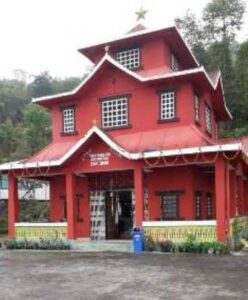
(Mangheems of few places)
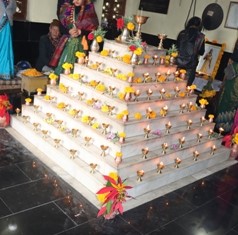

(Sangbe- inside the Mangheem represents as the Eight atmospheric
layers of mother earth and Altar for daily prayers or worship
by the priests/Phedangmas & devotees)
Spirit Possession in Limboo Priesthood or Limboo Shaman Priests:
The Limboo religious priests are defined as part time tutelary spirit possession Shamans who perform both Shamanistic and non-Shamanistic social ceremonies in the Limboo society, and hence known as Shamanistic priests. They perform shamanistic rituals through controlled state of ecstasy, trance or possession to gain intimate knowledge of supernatural beings, their where about, their mannerism, their desires, likes and dislikes, needs and requirements. They are specialist in human soul and therefore, perform manifest functions in the society. They are part time professionals of cures and healers and limit their activities to prayer, worship and religious offerings to supernatural beings. The Yuma religious practitioners are collectively known as Phedangmas. It is a general term for all types of Limboo religious practitioners. In classical term, they are recognized as “Sibhak-Yami Sa” which means (Si—Departed, Phak or Bhak—Cycle, Yami—Name, Sa—Individual) incarnate individuals having departed Divine souls. Thus, Phedangmas are reincarnate part-time religious practitioners. They officiate and perform all the life rituals and worship such as Pre-Natal womb worship, birth rituals, new born child naming to imitate the perceptive souls of the child, purify the new born pollution rituals, solemnize marriage weddings, death rituals, offerings of household divinities, harvest ceremonies etc. besides curing and healing of the sick.
The Limboo Religious Priests - Phedangmas
The Yuma religious practitioners are collectively known as Phedangmas. It is a general term for all types of Limboo religious practitioners. In a classical Mundhum language they recognize them self as “Sibhak-Yaming Sa” which means (Si—Departed, Phak or Bhak—Cycle, Yaming or Yami—Name of Sam Sire Deity/incarnate, Sa—Individual) incarnate individuals having departed Divine souls. Thus, Phedangmas are reincarnate part-time religious practitioners. One cannot become a Phedangma by learning Mundhums. At the most the layman learns Mundhums and officiate religious and social functions as “Yehang” (as a learned person) but cannot perform any religious worship. To become a Phedangma he must be reincarnate individual. Hence, the Limboos believe that the Phedangmas are reincarnate individuals having an additional soul of the departed dignitaries as “Sam Sire” recognized and sent by the Almighty Goddess Tagera Ningwaphuma. They officiate and perform all the life rituals and worship such as Pre-Natal womb worship, birth rituals, new born child naming to imitate the perceptive souls of the child, purify the new born pollution rituals, solemnize marriage weddings, death rituals, offerings of household divinities, harvest ceremonies etc. besides curing and healing of the sick. They are sole specialists, collect, retrieve the souls of the death, travel/accompany the souls to the land of ancestors, and finally hand over to the ancestors of the clan. They worship Mangs (Deities), Sammangs (Divinities) and Sammang Chyangs (Retinues of the Divinities) and able to retrieve the soul of the sick and thus cure the members of the community. Sometimes, they do divination to gain knowledge of supernatural beings their where about, their mannerism, their desires, likes and dislikes, needs and requirements through varieties of controlled state of ecstasy, Trans or possessions. However, most of the worship, religious life rituals, and social and religious functions are performed or controlled without controlled ecstasy, Trans and possession of their Sam Sire (Deity). A number of Anthropologists such as Jones (199: 29-55) Jones (1994, 22-28), Reinhard (1994; 12-18) and Sagant (1994; 56-99) have conducted field visit on the religious phenomenon of the Limboo religion and Phedangmas in Nepal, and have given us a good account of it. However, their study was focused only on pre-conceived notion of Shamanism. They failed to understand the believe system of “Yetcham” (Eight Soul Manifestation Tradition), incarnate status of Phedangmas, their recognition procedures etc.
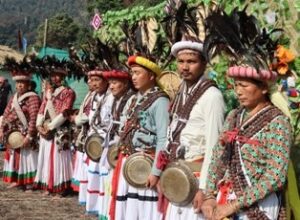

(Religious practitioners – Phedangma from different places)
Types of Phedangmas
Historically, the Limboos recognize nine types of Phedangmas. They are (i) Muhikkum Ongshi, (ii) Phejiri Phedangma, (iii) Samboko Samba, (iv) Yeboko Yeba, (v) Yeboko Yema, (vi) Yuma Sam, (vii) Sammundhum, (viii) Yepmundhum, (ix) Sidapangdang.
They differ in their gear or costumes known as Sama, their role in the religious functions in the community, worship methodology as cures, healers and offerings to supernatural beings. They are briefly described as follows:
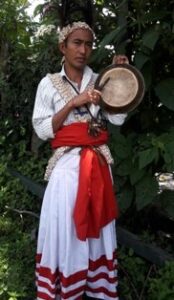

(Phedangma – Phejiri Phedangma)
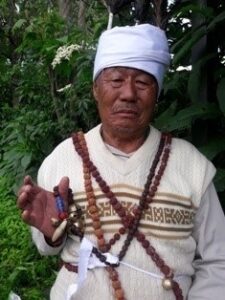

(Phedangma – Samboko Samba)



(Phedangma – Yeboko Yeba)

